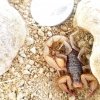many many legs
Arachnosquire
- Joined
- Jun 4, 2019
- Messages
- 63
Found it outside its burrow last night in ensenada, mexico. I've been seeing tons of tiny bark scorpions around here, but this one is much bigger and chunkier than them, maybe 4 inches. It also kicks around the sand in its enclosure, unlike my bark scorpions. Is it a desert hairy scorpion? That'd make my day 



